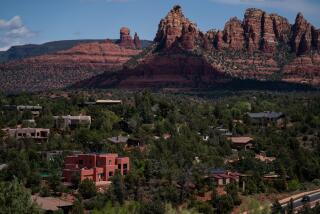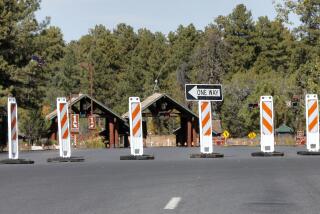‘Snowbirds’ Bring Golden Eggs to Arizona
PHOENIX — During the blistering summer, there’s hardly ever a wait for a table at The Crossing, one of Yuma’s most popular restaurants.
But it’s a different story come late fall and winter when Yuma, population 64,000, more than doubles in size with an invasion of heat-seeking “snowbirds.”
“This time of year you need a reservation every night or else it’s a 20- or 30-minute wait,” said Cindy Craig, who runs The Crossing, renowned for its $10.95 prime rib, with her husband, Todd. “Our business doubles.”
Like swallows returning to Capistrano, the annual migration of older folks and retirees fleeing the frozen North for sunny Arizona has begun. Vehicles bearing out-of-state license plates are reappearing, their occupants bound for hundreds of RV and mobile home parks scattered across the desert in Mesa, Apache Junction, Yuma and Quartzsite.
Whether they ride out the winter under the palms at a sprawling RV park, rent an apartment for a few months or drop in for a weekend at a posh Scottsdale resort, winter visitors are big business in Arizona.
Last year, more than 300,000 people wintered in RV and mobile home parks around the state, spending up to $1 billion, according to a survey conducted by the Center for Business Research at Arizona State University.
“We’ve shown seasonal residents inject half a billion dollars in the [Phoenix-area] economy in a three-month period of time,” said Stephen K. Happel, an economics professor at the university. “They just come in, don’t use a lot of services, basically party in the parks and leave.”
There are no estimates of how many winter tourists stayed in resorts or motels or other types of accommodations in 1995, but their economic impact is undoubtedly considerable, Happel said.
The 120,000 snowbirds who wintered in Phoenix’s eastern suburbs last year spent about $350 million, the economic equivalent of hosting a Super Bowl, said Dan Austin, president of the East Valley Winter Visitors Assn. in Mesa.
“There are many businesses here that are only open during the winter visitor season, like hair salons, Laundromats, restaurants and other service-oriented businesses,” said Darlene Grimes, a spokeswoman for the visitors’ association. “Many businesses are dependent on those visitors.”
The Yuma area expects about 80,000 visitors this winter, up about 7% from 1995. The increase is attributed to several new RV parks and advertising in frigid cities like Minneapolis.
Winter visitors accounted for most of the $380 million spent on tourism in Yuma County from April 1994 to May 1995, the last year for which figures are available, according to the Yuma Convention and Visitors Bureau.
“A lot of Yuma’s attraction is it’s a small city with all the conveniences of a big city but without the pollution and traffic. And the weather’s gorgeous,” said Courtney Castillo, the bureau’s executive director.
There’s more for snowbirds to do than just sit in the sun. There’s golf, of course, plus spring training baseball games. Many trailer parks offer activities ranging from archery to creative writing and photography classes.
The 50,000 winter visitors who inhabit six dozen RV parks and adjoining campgrounds on federal land at Quartzsite are drawn by prospecting, gem and mineral shows and the warmth.
“We love to go to the gem shows,” said Susan Graetzer of DeKalb, Ill., who has wintered in Quartzsite for a decade with her husband, Dale. “Everyone should have as much fun as we retired folks do here.”
Residents of cities where snowbirds flock often complain about increased traffic, but most of the grumbling is good natured.
“People get aggravated by the traffic, but the winter visitors are a real asset. Yuma wouldn’t be anything without them,” Cindy Craig said. “Yuma would dry up.”
For decades, the Phoenix area had a lock on winter visitors, but no longer, Happel said. The metropolitan area is about out of space for new RV and mobile home parks, and as a result snowbirds are spreading across the state to cities like Yuma, Prescott and Benson.
Happel predicts Arizona has a bright future as host to increasing numbers of winter residents, particularly aging baby boomers itching to spend their retirement years traveling.
“What I think you’re seeing is something I believe is going to magnify in the future: People living in travel trailers or Winnebagos, just moving around the country,” he said. “I think it bodes real well for Arizona.”
More to Read
Sign up for The Wild
We’ll help you find the best places to hike, bike and run, as well as the perfect silent spots for meditation and yoga.
You may occasionally receive promotional content from the Los Angeles Times.






